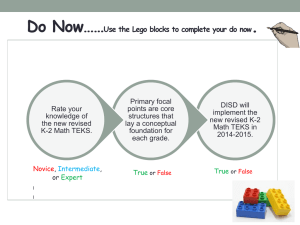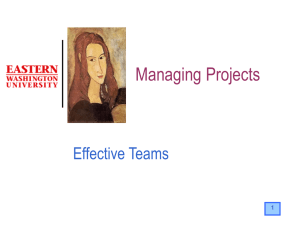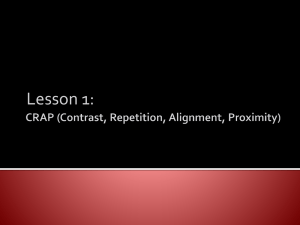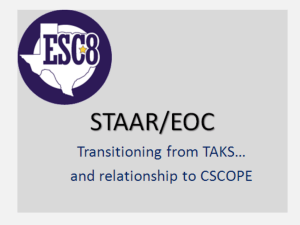VAD Tool Vertical Alignment Study
advertisement
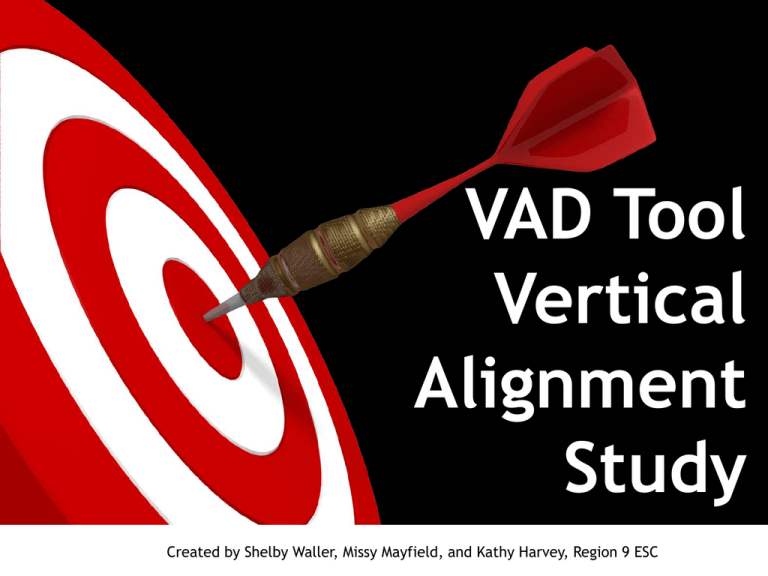
VAD Tool Vertical Alignment Study Created by Shelby Waller, Missy Mayfield, and Kathy Harvey, Region 9 ESC Vertical Alignment/TEKS Clarification Document Study The Guidelines for Your Lane Objectives 1. Pre-assess using the CSCOPE implementation rubric. 2. Build an understanding of the Vertical Alignment Documents (VADs). 3. Identify which content standards are introduced or transformed in a particular grade level. 4. Determine the differences in the cognitive and content specificity for the student expectations from one grade level or course to the next. Pre-assessment of Vertical Alignment Document Implementation CSCOPE Implementation Rubric What is my level of implementation of the Vertical Alignment Document? Rate the teachers in your district on their knowledge of Vertical Alignment: 1. Teachers are unaware of the concept of vertical alignment and are unable to discern gaps in textbooks, ancillary products, and/or specificity. 2. Teachers are aware of gaps in learning with incoming or outgoing students but no action is taken. Teachers are individually working from grade level to grade level. 3. Teachers are aware of gaps in learning with incoming or outgoing students. There is minimal evidence of collaboration among teachers regarding identified gaps.. 4. Teachers are aware of gaps in learning with incoming or outgoing students and routinely collaborate with other teachers regarding identified gaps. Level 5 Implementation 5. Teachers continually look for and identify gaps in learning with incoming and outgoing student by reflecting on the VADs, as well as data, and have professional dialogue with colleagues through the PLC. Build an Understanding of the Vertical Alignment/TEKS Clarification Documents Reviewing the Components ENGLISH LANGUAGE ARTS oK – 2nd o3rd – 5th o6th – 8th oEnglish I – English IV MATHEMATICS o K – 2nd o 3rd – 5th o 6th – 8th o Clarification Documents oAlgebra I oAlgebra II oGeometry oMath Models oPre-Calculus SCIENCE o K – 2nd o 3rd – 5th o 6th – 8th o Clarification Documents oIntegrated Physics and Chemistry oBiology oChemistry oPhysics oEnvironmental Science SOCIAL STUDIES/HISTORY o K – 3rd o 4th and 7th (Texas History) o 5th, 8th and United States History o 6th, World Geography and World History o Clarification Documents oEconomics oGovernment In this example, the strands are written into the knowledge and skills statement. The Student Expectation is written in bold black. This model of an ELA Vertical Alignment Document shows an example of a knowledge and skills statement that spans the four high school English courses. Specificity Specificity determines the rigor and complexity of the content that must be provided through the instruction. Cognitive Specificity Verbs from the knowledge and skills statement as well as the student expectation are highlighted to direct teachers to the level at which students should be performing. After the Cognitive Specificity, the CONTENT is highlighted in ALL CAPS. Specificity determines the rigor and complexity of the content that must be provided through instruction. Content Specificity Following the content in ALLCAPS, is the “Including, but not limited to,” bulleted items. “Including” means students must be given learning opportunities for each of the bulleted items. “…but not limited to,” means instruction can go beyond those items listed. CSCOPE Specificity Resources • • • • • • • • • • TAKS Information Booklets TAKS Study Guides Released TAKS Test National and State Standards AAAS – American Association for the Advancement of Science Early Childhood Research Texas Social Studies Tool Kit Charles A. Dana Center Tool Kit State Resources: Content State Trainings (MSTAR/ESTAR) TEKS Clarification Documents contain the same information found in a Vertical Alignment Document: title, strand, KS, SE, cognitive expectations, content expectations, specificity, and shading. K&S Statement Student Expectation VERBS (Cognitive Rigor) Content Specificity) The purpose of the TEKS Clarification Document is to provide further specificity for high school courses that do not necessarily align to specific earlier courses. Level 5 Processes and Tools Vertical Alignment Study Teachers continually look for and identify gaps in learning with incoming and outgoing students by reflecting on the Vertical Alignment Documents, as well as data, and have professional dialogue with colleagues through the Professional Learning Community. Our Goal Cognitive and Content Specificity Across Grade Bands The Vertical Alignment Study tool is used to document introduced and transformed student expectations as well as changes in cognitive and content specificity from one grade level to the next. Teachers may analyze TEKS by STRAND or by CSCOPE UNIT. Completing the Tool 4th Grade Math Geometry and Spatial Reasoning First, complete the header of the document. 4th Grade Math Geometry & Spatial Reasoning 4.9B Find the identifying number and letter for the student expectation. Record it in the TEKS row of the “MY LANE” column. 4th Grade Math Geometry & Spatial Reasoning 4.9B Connect, Use, Verify Find the verb or verbs written below the student expectation and record them in the cognitive specificity row of “MY LANE”. 4th Grade Math Geometry & Spatial Reasoning 4.9B Connect, Use, Verify Locate the content title written in ALL CAPS. Record it in the CONTENT TITLE row of the “MY LANE” column. Congruency of Transformations 4th Grade Math Geometry & Spatial Reasoning 3.9A 4.9B 5.8B Recognize, Identify Connect, Use, Verify Model, Identify, Generate Congruent Figures Congruency of Transformations Congruency of Transformations Follow the same process to complete the AFTER column. • Locate and write the TEKS Student Expectation Number. • Locate and write the VERBS. • Locate and write the CONTENT Title. Identify which Student Expectations are introduced or transformed in a particular grade level. Introduced or Transformed TEKS • An introduced Student Expectation would start in “your lane” and continue from there. • A transformed Student Expectation would stop in “your lane” or could be an altered Student Expectation. While 3.9A focused on “congruency,” 4th grade is the first time congruency of TRANSFORMATIONS Introduced are introduced, which is a completely NEW concept. Which best describes TEKS 4.9B ? Introduced or Transformed? Identify which Student Expectations are introduced or transformed in a particular grade level. Why could this be considered an introduced TEKS? What type of TEKS could this example represent? What is the significance of this particular situation? What is the significance of this type of alignment? TEKS Clarification Documents Science, Math, and History have TEKS Clarification Documents rather than VADs. The Vertical Alignment Study tool can also be used to study alignment between a high school course that has a clarification document and a previous grade level. In this example, a student expectation from Geometry will be mapped back to 8th grade. This 8th grade Student Expectation maps to the specificity of geometry TEKS in the Clarification Document. Bridging to a VAD Use the Vertical Alignment Document to complete the “before” column. Bridging to a VAD There may not be an alignment of Student Expectations for the courses following this one. Determine the differences in the cognitive and content specificity for the student expectation from one grade level or course to the next. Exploring Specificity • Using the science example of the tool, examine the three aligned student expectations. • Determine the differences in the cognitive and content specificity for the student expectation from one grade level or course to the next. • Record findings in the last two rows on the Vertical Alignment tool. 4th Grade Math Geometry & Spatial Reasoning 3.9A 4.9B 5.8B Recognize, Identify Connect, Use, Verify Model, Identify, Generate Congruent Figures Congruency of Transformations Congruency of Transformations 3rd Grade = Lower Blooms (knowledge/comprehension only) 4th Grade = Medium/High Blooms (moves into application/analysis/evaluation) 5th Grade = Lower/Medium Blooms (moves back to comprehension and application) Summary: Cognitive level increases in 4th grade, but decreases in 5th due to more difficult content in 5th. 3rd Grade = 2-D congruent figures only 4th Grade = Transformations introduced (translations, reflections, rotations) 5th Grade = Examples & non-examples of translations, reflections, & rotations on a coordinate grid; one figures producing more than 1 transformation Summary: content gets increasingly more difficult Small Group Debrief • How did the verbs change from one grade level to the next? • Were there any examples where changes were not found? What does that mean? • Were there any changes in the content title from one grade level to the next? How did they change? • What would happen if portions of the specificity were omitted or moved to another grade level? ON TARGET • Where does the YAG-0-MATIC fit into the bucket analogy? Bucket Analogy Revisited • • • • What do the holes in the bucket represent? What does the escaping water represent? What type of curricular issue is this? How did the leakage affect the lower grade band? Why might this be sobering news for primary campuses? • Describe the cumulative effect of the leakage from grade level to grade level. Who ends up holding the bag? • How might this leakage impact student performance on TAKS? VAD Study Work Session Created by Shelby Waller, Missy Mayfield, and Kathy Harvey, Region 9 ESC Work Session • Get a partner. • Decide on a content area or grade level that you & your partner would like to explore with the Vertical Alignment tool. • Look at the alignment of three different student expectations for a content area or grade level. – Choose 3 SEs from a specific STRAND or… – Choose 3 SEs from the next Unit’s IFD Where do we go from here for Level 5 Implementation? • VAD Study should be completed… – Prior to the beginning of each school year if done by TEKS Strand – Prior to each unit if done by Unit IFDs • Results/findings/discoveries must be documented – – – – PLC minutes Grade level meetings Vertical team meetings Other??? • The findings from the study should … – Guide professional dialogue – Lead to better instructional decisions – Lead to better prepared students ON TARGET Debriefing the YAG-O-MATIC and the VAD Tool • Without a thorough “debrief,” this TEKS exercise is just a timeconsuming checklist that has little value in teachers’ eyes. • Coaches MUST help teachers take their discoveries and transfer them to instruction.
